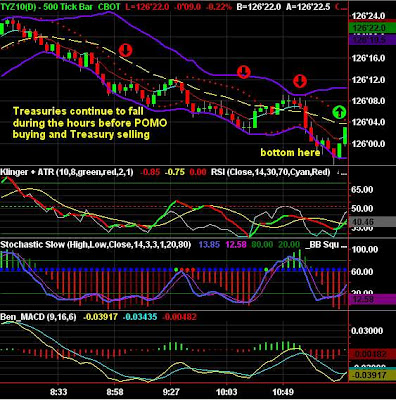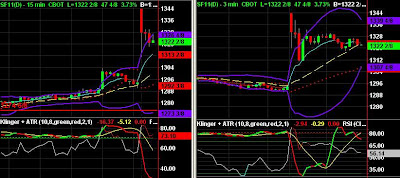by Elizabeth McDonald on Fox Business:
Is the Federal Reserve violating the U.S. Constitution’s separation of powers in its new purchases of $600 billion worth of U.S. Treasuries? Is the Fed engaging in an unconstitutional monetization of the U.S. Congress’ out of control spending spree that is really a bridge loan to fiscal insanity?
At minimum, should the Fed be avoiding these purchases until the fiscally debauched U.S. Congress, packed to the ceiling with fiscal dipsomaniacs, follows Great Britain’s lead in its fiscal abstinence that may "out Thatcher" even Margaret Thatcher?
Isn’t the problem fiscal incontinence and regulatory misfeasance, and business uncertainty about all of that, which is creating joblessness? Not a lack of liquidity and not deflation, which is not a clear and present danger, as instead inflation is still with us?
And isn’t the Fed dangerously habituating the stock, bond and commodities markets to a “new normal” of constant quantitative easing?
Open Revolt
Germany,
China, Russia and Brazil are attacking the Fed’s move. President
Barack Obama is now defending the Fed in his overseas trip to India. Former Republican vice presidential candidate
Sarah Palin demanded that the Fed "cease and desist" on its bond purchases.
Wall Street experts are now starting to call the Fed's moves an end run around the legislature.
And even Fed chairman Bernanke has criticized such extracurricular activity on the part of central banks in the past.
Watching closely in the wings are the Congressmen who want a full-fledged audit of the Fed, including Rep.
Ron Paul (R-Texas), who said he will push to examine the
Federal Reserve’s monetary policy decisions if he takes control of the Congressional subcommittee that oversees the central bank, as expected, in January.
Last week, the Federal Reserve announced it plans to buy more U.S. Treasury notes and bonds at a massive clip, $600 billion, between now and the end of June in a bid to spur economic demand, lower the jobless rate and resuscitate a still fragile U.S. economy.
Already, from December 2008 through this past March, the Federal Reserve bought about $1.6 trillion of government debt and mortgage-backed securities to stem the economy’s free fall.
Federal Reserve Act Sanctions Such Purchases
Although Article I of the Constitution specifically gives Congress the power to "borrow," "coin" and "regulate" money, a little understood section of the Federal Reserve Act, section 14(b)(1), does let the Fed buy Treasuries in the open market — and under the Act the central bank can buy foreign debt, too. But that act, put in place in the early part of the 20th century, was meant for smaller bore purchases to help the government build bridges and roads--not the massive intervention planned now. Fed historians fear the central bank is now pushing the envelope of the Federal Reserve Act. For more on the section, click
here.
Why the Fed Intervention?
The banks say there is still a lack of demand, at the consumer and business levels. Banks are being criticized for not lending more, even though the Fed has kept interest rates at nearly zero, and even though they hold more than $1 trillion in excess reserves. Loans as a percentage of assets are declining, notes the Dallas Federal Reserve, although it sees a pickup in bank corporate lending.
The central bank hopes to lower the 10-year note even more, helping homeowners teetering on the brink to refinance their mortgages and businesses to obtain cheaper credit.
The Heart of the Problem
The problem is, businesses say they face hyper-taxation and hyper-regulation at the federal, state and local, and that is what is helping to create joblessness. Fed officials agree.
“The remedy for what ails the economy is, in my view, in the hands of the fiscal and regulatory authorities, not the Fed," said Richard Fisher, president and CEO of the Federal Reserve Bank of Dallas in a speech to members of the Association of Financial Professional that was critical of the central bank’s debt purchases.
Uncertainty rightfully abounds in the business community because businesses do not know what else will pop up in the health and financial reform bills that many in Congress have not read that could hurt their businesses.
The problem is the Fed is buying much of next year’s fiscal deficit spending at a time when fiscal austerity is nowhere to be found in Congress. The problem is the Fed won’t stop buying Treasuries unless the government fixes a jobless rate stuck at 9.6%, the goals of “maximum employment” being part of the Fed’s mandate.
The problem is this vicious circle: the Fed’s dollar printing could undo the government’s stimulus deficit spending because it will cause the dollar to drop and it will trigger inflation, as already food and gas prices have risen, hurting the U.S. consumer.
The danger is monetary policy acts with a lag. “I liken it to a good single malt whiskey or perhaps truly great tequila: It takes time before you feel its full effect,” says the Dallas Federal Reserve’s Fisher.
So the Fed’s moves could take effect when the economy is already healing — igniting inflation, which the U.S. already sees in food and energy prices.
The Markets Cheer
The stock markets have cheered, and the
Dow Jones Industrial Average has risen 12% higher as the dollar has dropped about 10% versus the euro since Federal Reserve chairman
Ben Bernanke first hinted at more purchases in his Jackson Hole, Wyoming speech last August.

U.S. Federal Reserve Chairman Ben Bernanke (Source: Reuters)
Investors have seen an estimated $1.4 trillion in paper gains in their portfolios since then, the wealth effect Bernanke had hoped for to revive
consumer confidence and spending.
However, market watchers now fear a trifecta of bubbles is forming in stocks, bonds and commodities — and foreign governments, notably in Asia, are hollering that this flood of money is ending up on their shores creating bubbles there, too.
Already, as the dollar drops, oil is trading at two-year highs, and gold has hit a nominal high of $1,400, still off its inflation adjusted high of $2,314 reached in 1980.
“Right now, the world is faced with the unprecedented consequence of demand-pull inflationary forces fueled by the voracious consumption of oil, wheat, corn, iron ore, steel and copper, and all other kinds of commodities and inputs, including labor, among the three billion new participants in the global economy,” says Fisher.
But instead of what former Fed chairman William McChesney Martin once famously said -- that the job of a good central banker is to take away the punchbowl just as the party gets going -- Bernanke is spiking the bowl even more.
Fed’s Scary Exit Strategy
And another gargantuan problem looming is the Fed’s exit strategy out of its dollar printing, which involves selling those exact same Treasuries it is buying to remove the excess liquidity the central bank is creating.
All of those bonds seeking a finite pool of investors could cause a bond market crack up, because higher yields would have to be offered to lure investors in.
The Fed’s exit strategy could cause bond yields and borrowing rates to spike way higher.
Controversy Stretches Back Decades
Since the Federal Reserve Act of 1913 created the Fed, scholars have argued the Fed itself as an entity is unconstitutional. Texas Republican Rep. Ron Paul and his newly elected son Rand have made similar arguments.
FOX Business' top legal analyst, Judge Andrew Napolitano, notes that “the
Supreme Court has never ruled on the constitutionality of the Federal Reserve, believe it or not. But the lower federal courts that have addressed the issue have found it to be constitutional by employing the argument that Congress can enter into a contract with private entities to perform governmental services; and that is what it has done with the private bankers who own and operate and profit greatly from the Fed.”
Fox Business news director Ray Hennessey notes that in 1952, Rep. John Wright Patman of Texas, who was head of what was then called the House Committee on Banking and Currency, crystallized the argument, saying, “In the United States we have, in effect, two governments. We have the duly constituted Government. Then we have an independent, uncontrolled and uncoordinated government in the Federal Reserve System, operating the money powers which are reserved to Congress by the Constitution."
The U.S. central bank grudgingly bought U.S. debt during the Great Depression under pressure from Congress to battle deflation—a playbook Bernanke is following now.
Between 1926 and 1929, the Fed bought $1.7 billion in US debt, but then ramped that up from $729 million to $1.8 billion in 1933, averaging $2.4 billion in purchases every year after that until 1941.
While these moves helped lower interest costs corporate debt “and appeared to arrest the decline in prices and economic activity,” Bernanke said. “Fed officials remained ambivalent about their policy of monetary expansion. Some viewed the Depression as the necessary purging of financial excesses built up during the 1920s..slowing the economic collapse by easing monetary policy only delayed the inevitable adjustment.”
The Fed also bought U.S. debt in the 1940s to keep interest rates low after
World War II, a move some economists say helped usher in the post-war economic boom.
And back in the 1970s, it was Congress that pressured the Fed into adding
Fannie Mae and
Freddie Mac securities to its portfolio in order to help develop the market for those mortgage-backed securities. That was unpopular with the Fed at the time too.
Bernanke Uncomfortable
Fed chairman Bernanke himself said he was nervous about such extracurricular moves by any central bank in a 1999 speech, where he discussed the Bank of Japan’s monetary easing to help fix the country’s banking collapse that led to its lost decade of the ‘90s, now two decades running.
Bernanke said that if the BOJ outright bought nonperforming bank loans, such purchases would be “correctly viewed as an end run around the authority of the legislature, and so are better left in the realm of theoretical curiosities.”
But the Fed effectively did make such a monetary gift to Fannie Mae and Freddie Mac when it bought its rotten mortgage-backed securities, notes John Hussman of Hussman Funds.
Hussman says: “It is doubtful that when Congress drafted the Federal Reserve Act to allow the use of mortgage-backed securities, it ever dreamed that the Fed would purchase these securities outright when the issuer was insolvent. Until this issue is clarified in legislation, Bernanke will continue to see it as “perfectly sensible” for the Fed to make ‘money financed gifts’ that substitute his own personal discretion for those of a democracy.”
Quantitative easing simply lets the Fed to not just buy Treasuries, but also other assets that may not be allowed by the Constitution, Hussman says.
“Creating government liabilities to acquire goods and assets, unless those assets are other government liabilities, is fiscal policy, pure and simple” and “that fiscal authority is enumerated by the Constitution as the sole right of Congress,” Hussman notes.
And “nowhere in the Federal Reserve Act did Congress provide authority for the Fed to create subsidiary corporate entities as it did with the Maiden Lane vehicles,” to take on rotten assets from
Bear Stearns and AIG, says Chad Emerson of the William & Mary Business Law Review. “The Fed cannot simply establish off-the-books shadow companies to avoid its restrictions under the Act. The legislative power of Congress cannot be circumvented by merely creating a LLC.”
When Bernanke Acted
Bernanke first raised the idea of purchasing Treasuries in a Dec. 1, 2008 speech, which the Federal Open Market Committee later reaffirmed in a statement on Jan. 28, 2009. But when the
Bank of England later that year succeeded in dropping long-term rates by buying U.K. gilts, that’s when the Fed took notice. The 10-year gilt yield slid to the lowest level in at least 20 years after the BOE’s purchases began.
But Great Britain became abstemious with its deficit spending. The U.S. has not.




























